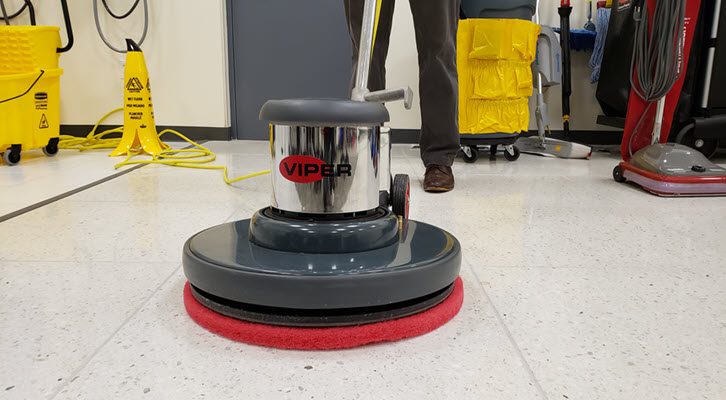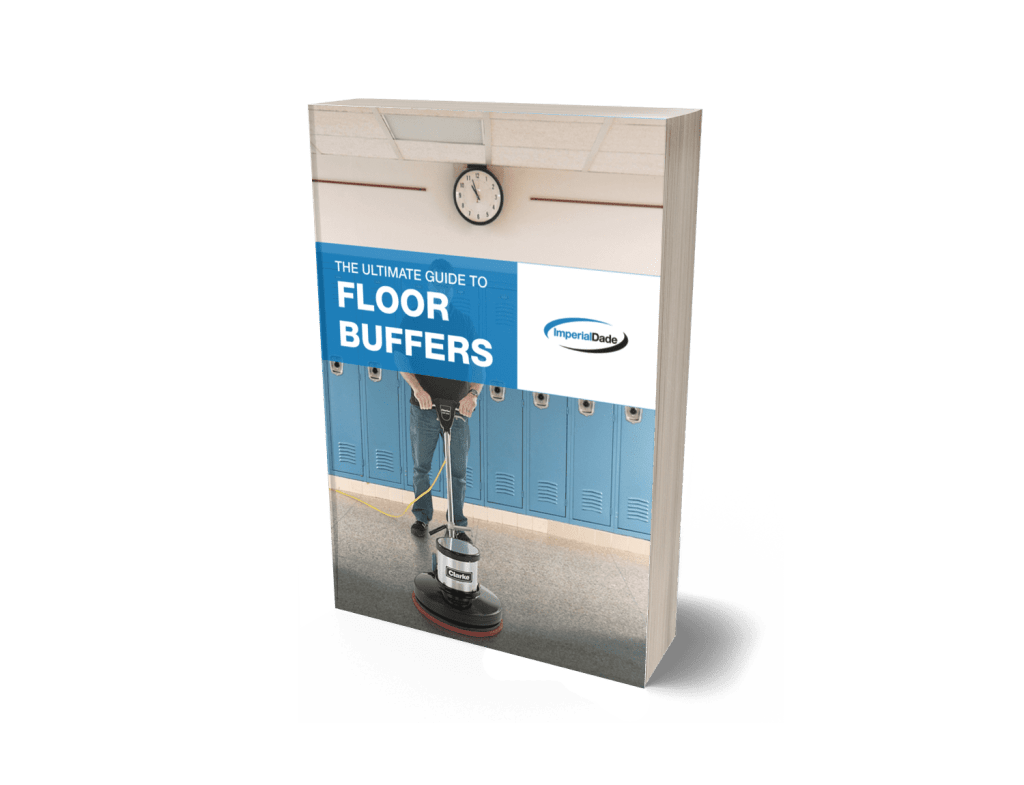In many facility’s, periodic scrubbing, buffing, stripping, and cleaning of commercial floors are necessary to keep the floors looking great. Investing in the right commercial floor buffer will provide labor & time savings, increased cleaning results, and better machine reliability.
Once you determine you need a floor buffer, you’re likely curious about how much one is going to cost you.
Choosing which floor buffer is best for your facility may have a lot to do with price, but when evaluating the cost, you should consider what you’re going to get for the price of the floor buffer.
Just picking the cheapest or most expensive floor buffer may not be the best option for your facility.
How Much is a Floor Buffer?
A 20-inch floor buffer typically ranges from $750.00 to $2,950.00. There are many factors that will ultimately affect the price.
When evaluating the cost of a floor buffer, you should consider the machine features and the total cost of ownership to help determine if you are making the right investment.
In this article, we will go over six factors that will affect the cost of your floor buffer.
The initial cost of your commercial floor buffer is the upfront cost or purchase price. The initial cost of a commercial floor buffer will be affected by:
1. Deck Size
2. Motor Size
3. Gearbox vs Belt Driven
The total cost of ownership is the total of expenses after the initial purchase. The total lifetime cost of a floor buffer will include things like:
4. Warranty
5. Service and Support (Preventative Maintenance)
6. Delivery, Set-Up, & Training
1. Deck Size
Buffers are typically offered in 13-inch, 17-inch, and 20-inch. The smaller the cleaning path, the less the floor buffer will cost.
Depending on the size of the area being cleaned, it may not be beneficial to get the smallest buffer. The smaller the cleaning path, the longer it will take to complete a cleaning procedure. The more time employees spend on a cleaning procedure, the less work they can complete.
The most common floor buffer is the 20-inch. 20-inch buffers are typically used to complete floor maintenance procedures in open areas. 17-inch buffers are best used in smaller, more congested areas where a 20-inch machine won’t fit. 13-inch buffers are the smallest commercial floor buffer. They are most commonly used in bathrooms or on stairways.
2. Motor
Size
Floor buffers have motors between .5 – 1.5 horsepower (hp). Most buffers have a 1.5 hp motor. The higher the horsepower, the more power the machine will have to rotate the floor pad.
The larger the motor, the higher the price of the floor buffer. However, investing in a larger motor can help extend the life of your floor buffer. Floor buffers with larger motors put less stress on the machine reducing wear and tear.
3. Gearbox vs Belt Driven
Floor buffers either contain a gearbox or drive belt.
Triple vs Single or Double Planetary Gears
Commercial floor buffers can have single, double, or triple planetary gearboxes. The gearbox provides power and stability to rotate the floor pad in a balanced motion.
Triple planetary gearboxes are the most expensive option. In a triple planetary gearbox, the gearbox is balanced by three evenly spaced gears.
The three gears allow the gearbox to rotate evenly providing the best torque and balance control. Triple planetary gears are the most durable and longest lasting.
Single or double planetary gearboxes do not fully balance the power across the gearbox and are not as good as a triple planetary gearbox.
A double planetary gearbox has two gears that are on opposite sides of each other. This provides better balance control than a single planetary gearbox but causes the gearbox to rotate unevenly. The stress of the uneven rotation will shorten the life of the machine.
Single planetary gearboxes are the cheapest option but also provide the least balance. They are also the least durable and have the shortest machine life. Single planetary gearboxes are likely to require the most maintenance and cause the most machine downtime and lowest worker productivity when compared to double or triple planetary gearboxes.
Belt Driven
There is no gearbox in a belt driven unit. In a belt driven unit, the motor drives a belt which in turn spins the floor pad or brush. Belt driven units can feature lower noise and vibration levels to help minimize interruptions during daytime cleaning procedures.
Unlike a machine with a gearbox, the motor is offset to the side of the machine causing the buffer to be less balanced. To operate a belt driven unit, the operator must make up for the imbalance of the motor. This causes the operator to work harder increasing worker fatigue and reducing worker productivity.
Belt driven units can require more maintenance and repair costs than a gearbox operated buffer. Belts can become worn and slip, increasing the likelihood of machine downtime and lower worker productivity.
4. Service and Support (Preventative Maintenance)
Preventative maintenance can help extend the life of your commercial floor buffer and reduce the need for more costly repairs. Although the added service may cost you more initially, preventative maintenance will help safeguard your investment. It will also prevent unscheduled equipment downtime and lost worker productivity.
5. Delivery, Set-Up, & Training
To get the most out of your equipment investment, take into consideration the cost of machine delivery, set-up, and training. Proper machine set up and employee training are important in ensuring the correct usage and maintenance of the floor buffer. Proper usage and training will reduce equipment downtime, extend the life of your machine, and maximize employee productivity.
6. Warranty
Floor buffers come with a warranty on parts, which will allow you to keep your repair costs down.
Most warranty on parts is between 2-3 years but can range from 2-7 years. In general, the longer the warranty, the more expensive the machine.
Final Thoughts
Selecting the best buffer for your facility may ultimately come down to price, but knowing when the cheapest one may not be the best investment is important.
The cost of a commercial floor buffer is more than just the purchase price. You must take into account the total cost of ownership when making this investment.
The right machine for your facility is not the one with the cheapest purchase price, but the one that delivers the best payback period and return on investment (ROI). It is important to note that a machine with a higher initial cost may be the cheaper option over its lifetime.
Choosing an industrial floor buffer that has a warranty on parts or comes with in-service training and support will allow you to recoup your initial investment in a shorter amount of time than if you selected the cheapest machine with no warranty or training. A cheaper machine may not have the same useful life or provide a warranty on parts which will otherwise cost you more in repairs, unplanned equipment downtime, and lost worker productivity in the long run.
EBP and other Imperial Dade locations have a large selection of professional floor buffers and other janitorial cleaning equipment to help maintain the appearance and cleanliness of your facility’s hard floors. If you have a question about which floor buffer would be the right investment for your facility, let an Imperial Dade Equipment Specialist help.
Whether you’re located in the United States, Puerto Rico, or the Caribbean, our team will work to understand your needs and desired outcomes so we can suggest the best equipment choices for you. We will guide you through the decision-making process to ensure you make the right purchase.

